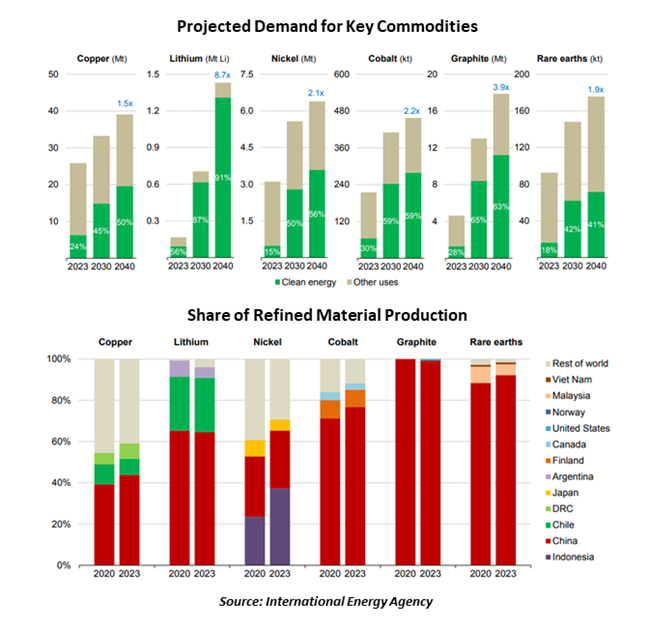- Who We Serve
- What We Do
- About Us
- Insights & Research
- Who We Serve
- What We Do
- About Us
- Insights & Research
Unearthing The Future
Mining brings economic benefit and environmental costs.
By Carl Tannenbaum
Mining is one of the world’s oldest industries. There is evidence that humans were digging for coal more than 20,000 years ago. Civilizations were excavating metals as early as 8,000 BCE.
Interestingly, this most ancient of endeavors is critical to the economy of the future. Adapting to climate change and applying artificial intelligence (AI) will require lots of essential minerals. Natural and strategic limitations on mining may slow technological process in the years ahead.
Mining directly accounts for about 7% of global gross domestic product (GDP). But the World Economic Forum estimates that mining output is essential to almost half of global GDP. A look at the cutting edge of commerce illustrates why.
Electric vehicles (EVs) are thought to be the wave of the future for ground transportation. EVs account for an increasing share of car sales, but many motorists suffer from “range anxiety,” a fear of losing power before reaching destinations. In most countries, networks of charging stations are insufficient. Some homes can accommodate chargers on the premises, but millions park streetside where it is difficult to plug in.
Energy transition is another high-priority global economic initiative. Curtailing carbon emissions has prompted the development of alternative sources of power. Wind and solar generation are intermittent and cannot fully replace conventional energy without cells to store excess production. Transmitting this power to electric grids requires an extensive network of repositories.
Batteries with substantial capacity are critical in both of these areas. Those batteries require copious amounts of copper, lithium, cobalt and other elements. According to the International Energy Agency (IEA), an EV requires six times more minerals than a conventional vehicle. A typical wind farm requires nine times the essential minerals than a natural gas-powered plant to generate the same amount of electricity.
Global demand for power is expected to soar in the years ahead, thanks to increasing adoption of EVs and the needs of data centers supporting AI. Sating this appetite while honoring environmental goals will place a heavy burden on global mining. Under a reasonable scenario for the years ahead, the IEA estimates that mineral production will have to increase by two to nine times from current levels, depending on the ingredient.
In some cases, demand for global mineral reserves could exceed natural supplies. McKinsey found that the availability of lithium from primary sources may not be sufficient to support battery production through the end of this decade. Recycling could provide a considerable assist, but that process is in its early stages.
Ownership of mineral reserves has become more concentrated, with China taking a leading role. As countries compete to be first and best in cutting-edge industries, their willingness to share essential materials has diminished. The standoff creates dislocation between the supplies of raw materials and factories which need them, limiting progress.

Some of the world’s newest industries are dependent on one of the oldest.
Mining can have negative consequences for the environment. The process uses a lot of energy and water, and leaves scars on the landscape. There is risk of soil and groundwater contamination. Conditions in the mines can be dangerous, and labor practices aren’t always the best.
Countries have been hesitant to grant permits for new facilities, given the impact on local populations. The industry doesn’t typically score well on Environmental, Social and Governance (ESG) scales, which can limit its ability to attract capital. Ironically, the path to a greener future includes some brown spots.
Our aspiration for new economic heights may be brought back to earth by activities which are almost as old as time. The green transition could find itself between rocks and hard places.
Related Articles
Read Past Articles
Meet Our Team

Carl R. Tannenbaum
Chief Economist

Ryan James Boyle
Chief U.S. Economist

Vaibhav Tandon
Chief International Economist
Subscribe to Publications on Economic Trends & Insights
Gain insight into economic developments and our latest forecasts for the United States.
Information is not intended to be and should not be construed as an offer, solicitation or recommendation with respect to any transaction and should not be treated as legal advice, investment advice or tax advice. Under no circumstances should you rely upon this information as a substitute for obtaining specific legal or tax advice from your own professional legal or tax advisors. Information is subject to change based on market or other conditions and is not intended to influence your investment decisions.
© 2025 Northern Trust Corporation. Head Office: 50 South La Salle Street, Chicago, Illinois 60603 U.S.A. Incorporated with limited liability in the U.S. Products and services provided by subsidiaries of Northern Trust Corporation may vary in different markets and are offered in accordance with local regulation. For legal and regulatory information about individual market offices, visit northerntrust.com/terms-and-conditions.